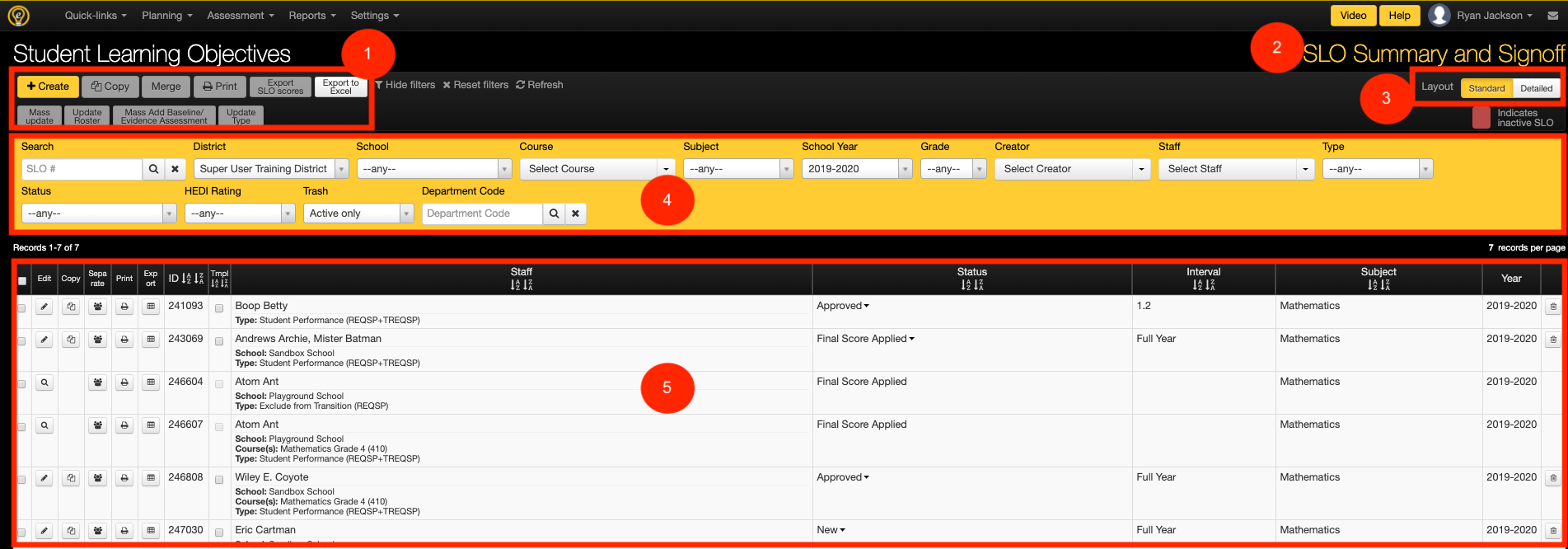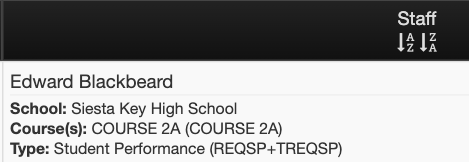Student Learning Objective Homepage (SLOs)
Creating and Managing Student Learning Objectives has never been easier. The Student Learning Objectives Homepage is the location where all SLOs can be created and monitored within eDoctrina. Each student learning objective that the logged in user has access to will be listed here so teachers can always view/enter data for their own SLOs, while administrators can review these for all teachers that they have a vested interest in. Each SLO will normally go through a standardized workflow, which is usually defined at the beginning of the school year and these workflow states can be seen, filtered for, and updated right from this page.

-
Top Buttons
The buttons on the top of any page are usually designed to either perform a mass update action on many items in the list, print many items at once, or generate some other report that references the listed items.

 ==> If a button is marked with this blue icon, then the button is typically not available to teachers.
==> If a button is marked with this blue icon, then the button is typically not available to teachers.- + Create: The create button will be available for any user that has the permissions to create a new student learning objective. If this button is unavailable, it usually means SLOs are auto-generated or created/assigned by a district administrator which means there would be no need for an SLO to be created by the logged-in user anyway.
- Copy: Select the checkbox next to each SLO that needs to be copied and use this button to copy all items in one action. Individual items can be copied using the button in the list.
-
Merge
 :
The Merge button is used to combine one of more SLOs resulting in one target SLO.
:
The Merge button is used to combine one of more SLOs resulting in one target SLO.
- Print: The option to print one or many SLOs exists from the SLO Homepage.
-
Export SLO Scores
 : All entered scores for the student population can be easily exported to a Microsoft Excel file.
: All entered scores for the student population can be easily exported to a Microsoft Excel file. -
Export to Excel
 : This export to excel tool is one of the more comprehensive tools as there are two different formats with many different fields to choose from. If it is desired to generate some spreadheet of all SLOs in eDoctrina, this could be a great report to include the data that is necessary.
: This export to excel tool is one of the more comprehensive tools as there are two different formats with many different fields to choose from. If it is desired to generate some spreadheet of all SLOs in eDoctrina, this could be a great report to include the data that is necessary. -
Mass Update
 : The mass update tool currently allows for mass update of the SLO Workflow state for the selected SLOs.
: The mass update tool currently allows for mass update of the SLO Workflow state for the selected SLOs. -
Update Roster
 : The update roster tool is designed to keep the student population within the selected SLOs to be as current as possible. Upon selection, the system will present a pop-up explaining that the application will check all linked teachers, the course, and semester code to add any newly enrolled students or remove any students who have unenrolled.
: The update roster tool is designed to keep the student population within the selected SLOs to be as current as possible. Upon selection, the system will present a pop-up explaining that the application will check all linked teachers, the course, and semester code to add any newly enrolled students or remove any students who have unenrolled. -
Mass Add Baseline/Evidence Assessment
 : The mass add assessment tool allows for for easy addition of baseline or evidence assessments to one or many selected SLOs. The option to mass remove does not currently exist.
: The mass add assessment tool allows for for easy addition of baseline or evidence assessments to one or many selected SLOs. The option to mass remove does not currently exist. - Update Type: The type often determines how SLO scores will be calculated and combined. This tool allows for mass update of the SLO Type in the instances where many SLOs need to be updated.
-
Link to SLO Summary Sheet:
The SLO Summary sheet is the page where the selected SLO scores are combined for each staff member and is a great place to manage and monitor how SLOs are calculated for each staff member. This is also a great place for error identification as the scores are able to be filtered and viewed in a nice list format separated by data source. The reason why this link is here for easy toggling between the SLO Homepage and the SLO Summary Sheet.
-
Layout
The layout determines how the Student Learning Objectives will be displayed in the list on the Student Learning Objective Homepage.
-
STANDARD:

-
DETAILED:

-
STANDARD:
-
Filters
Each of the filters available on the Student Learning Objective Homepage allows for filtering the displayed list in accordance with the entered or selected filters. The available filters depend on user permissions and other conditions, so if there is a necessary filter that is shown in the list below that is needed, please contact a district administrator or an eDoctrina team member. Please note that the selected filters will only return items in the list that match all of the selected parameters. If an item cannot be found, try starting over by resetting the filters. They are also "sticky" filters so all previous selections should be preserved if visiting the page again on the same browser and device.- Search: The Search field allows for searching by the SLO ID# only. If a staff member name is being searched upon, then use the "Staff" filter.
- District: The district filter will only be available for users that have access to multiple districts allowing for filtering in accordance with the district that the SLOs are linked to. In most cases, users are only linked to one district so this filter will often be hidden.
- School: The school filter will only be available for users that have access to multiple schools allowing for filtering in accordance with the school that the SLOs are linked to.
- Course: It is possible to filter SLOs by the course that they are linked to. Each user will be able to select one or many courses to filter for as long as they have access to the the course.
- Subject: The subject filter will contain all of the Subject areas that are available within the district to allow for narrowing down the list by specific subject areas. This is a required field for SLOs, therefore all SLOs will be linked to some subject.
- School Year: The default selection for the School Year filter is to be the current year, but this can be updated to view SLOs that may exist in past and future years as well.
- Grade: The grade filter will contain all of the grade levels that are available within the district to allow for narrowing down the list by specific grades. This is a required multi-select field for SLOs, therefore all SLOs will be linked to one or many grades.
- Creator: The creator of the SLO could be different than the Staff that are linked. This is a great filter for individuals who create SLOs for staff members so they can easily obtain a list of SLOs that they have created within the district.
- Staff: The staff filter can be used to select one or many staff members to identify any SLO that they are linked to. This is the best way to find SLOs for specific staff members.
- Type: The SLO Type is how the scores for student learning objectives are linked to a data source and communicated with the teacher effectiveness system. The SLO Type aligns the scores on the SLO Summary and is vitally important to select the correct value for proper categorization. The SLO Types are configured by the eDoctrina team as these are usually consistent for each U.S. State.
- Status: The status filter allows for narrowing down the displayed list to SLOs that are in a specific workflow state. If using SLO workflow states, then each SLO usually goes through a common life cycle that may include some points of approval or other required tasks. SLO workflow states are configured for each district.
- HEDI Rating: The HEDI rating filter allows for quick identification of any SLOs that have a final rating selected, not selected, or even for SLOs that do not have a HEDI/Attainment table.
- Trash: The trash filter allows for filtering for Active, Inactive, or All student learning objectives in the list and this filter will only be available to administrative users.
- Department Code: The department code can be used to filter for all SLOs for staff members that match the entered department code. These codes vary greatly by district, so try to understand what department codes are available within the district before using this filter.
-
SLO List

The edit pencil will be available for all SLOs that the logged-in user has access to. Click this button to enter the SLO Editor for the desired student learning objective.

The copy button is available for all users who have permissions to copy SLOs and will be available for all SLOs that the logged in user has access to.

The separate SLO button is only available to administrative profiles and should be used to create individual SLOs that utilize the same SLO descriptions and criteria as a previously created group SLO.

The print button will be available for all SLOs that the logged-in user has access to providing the ability to print individual SLOs.

The Export button is available for administrative users and allows for the SLO scores for the linked students in the population to be easily loaded into a Microsoft Excel spreadsheet.

The Staff column will display the names of the linked staff members, the school, the course, and the SLO Type. If more details are necessary, try the Detailed view.

The Status will display the current SLO workflow state for each SLO and there is the possibility for updating this right in the list by selectign the desired workflow state from the pull-down. The Interval will display the entered time period that has been entered for the SLO. This option can be limited to semester codes that have been entered for the district if this selection is to be more rigid. The Subject will display the subject that the SLo is linked to and the Year will display the year that the SLO is linked to.
 Save as PDF
Save as PDF